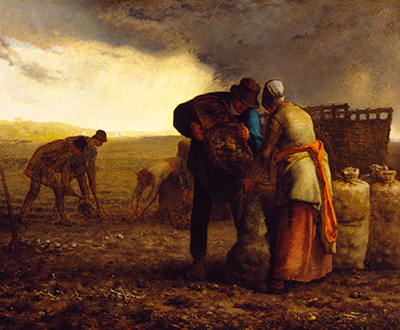The Potato Harvest is an oil on canvas painting by Jean Francois Millet done in the year 1855. The paint depicts farmers working on the plains between Barbizon and Chailly. The main theme of the paint represents the peasant's struggle for survival. The techniques used by Jean in The Potato Harvest incorporate paste-like pigments thickly applied over a coarse canvas.
The Potato Harvest was greatly influenced by the lives of Jean's neighbors, portraying the difficulties farmers undergo. It can also be interpreted to highlight the social injustices of farmers of his time.
The right side of the painting shows a farmer pouring a basket of potatoes into a sack that is held open by a woman. Besides them are three full sacks and a cart is also visible, most likely for the transportation of the potatoes.
Further back, on the left side of the picture, two young boys are seen digging potatoes which are gathered by an elderly woman. Back in the background, the sky is illuminated with warm sunlight, while the right side is dark, nimbus clouds threatening a low lying rain. The sense of fatigue and repetition is highly depicted in the paint.
The potato Harvest encompasses the activities the farmers are doing while at the same time showing the beautiful landscape. The colors used are harmonious and complement the mood of the paint. A bigger portion of the artwork is covered in dark brown color which covers the entire potato field.
What influenced Jean-Francois Millet's style of painting was the fact that he grew up helping his father with the farm work. Also, after been sent to Cherbourg to study painting under Bon Du Mouchel, this enabled him to pick some techniques and styles from his tutor.
He also studied Ecole des Beaux-Arts with Paul Delaroche. Millet was also an important figure for Vincent Van Gogh, especially during his earlier years. His work is also mentioned several in Vincent letters to Theo, his brother. His pictures of the landscape are also influential reference points in Claude Monet's painting of Normandy.
He is also the main subject in Mark Twain's play, Is He Dead?. His painting L`homme a la house greatly influenced the famous poem, The man With the Hoe done by Edwin Markham. Millets' other paintings include a portrait of Louise Alexandre Marolles of 1841 and The Abduction of the Sabine Woman done between 1844 and 1847.




